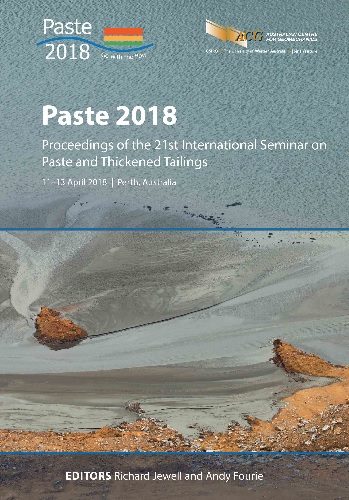Effect of additives on suspension pipe flow

|
Authors: Graham, LJW; Short, G; Chryss, A; Constanti-Carey , K; Wu, J |
DOI https://doi.org/10.36487/ACG_rep/1805_13_Graham
Cite As:
Graham, LJW, Short, G, Chryss, A, Constanti-Carey , K & Wu, J 2018, 'Effect of additives on suspension pipe flow', in RJ Jewell & AB Fourie (eds), Paste 2018: Proceedings of the 21st International Seminar on Paste and Thickened Tailings, Australian Centre for Geomechanics, Perth, pp. 169-180, https://doi.org/10.36487/ACG_rep/1805_13_Graham
Abstract:
Suspension pipe flow is an important part of mineral operations, which can involve concentrate transport, intra-plant transport, tailings disposal and backfill. Significant costs in these operations include energy, capital and maintenance (the latter associated with the repair of erosion damage). Full understanding of the flow regime is required to optimise the design of these systems for the desired operating condition. An additional option available to the pipe designer or operator is that additives such as magnesium aluminosilicate (MAS) can be used to change the flow regime of the pipe system to the advantage of the operation. A recent program has investigated some of these aspects of pipe flow experimentally. It was found that: Future research options could include examining the effect of additives on different clay-based model suspensions and industrial samples.
Keywords: non-Newtonian, pipe, additives, rheology, magnesium aluminosilicate
References:
Gillies, RG, Schaan, J, Sumner, RJ, Mckibben, MJ & Shook, CA 2000, ‘Deposition velocities for Newtonian slurries in turbulent flow’, The Canadian Journal of Chemical Engineering, vol. 78, no. 4, pp. 704–708.
Matousek, V, Penik, V, Pullum, L & Chryss, A 2015, ‘Experimental study of bed friction in stratified flow with viscoplastic carrier in pipe’, in J Sobota and C van Rhee (eds), Proceedings of the 17th International Conference on Transport and Sedimentation of Solid Particles, Wroclaw University of Environmental and Life Sciences, Wroclaw, pp. 175–184.
Pullum, L, Graham, LJW & Slatter, P 2004, ‘A non-Newtonian two-layer model and its application to high density hydrotransport’,
in N Heywood (ed.), Proceedings of the 16th International Conference on Hydraulic Transport of Solids, vol. 2, BHR Group, Cranfield, pp. 579–594.
Rojas, MR & Saez, AE 2012, ‘Two-layer model for horizontal pipe flow of Newtonian and Non-Newtonian settling dense slurries’, Industrial & Engineering Chemistry Research, vol. 51, no. 20, pp. 7095–7103.
Sanders, RS & Sumner, RJ (eds) 2014, Proceedings of the 19th International Conference on Hydrotransport, BHR Group, Cranfield.
Shook, CA, Gillies, RG & Sanders, RS 2002, Pipeline Hydrotransport with Applications in the Oil Sands Industry, Saskatchewan Research Council publication number 11508-1E02, Saskatchewan Research Council Pipe Flow Technology Centre, Saskatoon.
Talmon, AM, van Kesteren, WGM, Mastbergen, DR, Pennekamp, JGS & Sheets, B 2014, ‘Calculation methodology for segregation of solids in non-Newtonian carrier fluids’, in RJ Jewell, AB Fourie, PS Wells and D van Zyl (eds), Proceedings of the 17th International Seminar on Paste and Thickened Tailings, InfoMine Inc., Vancouver, pp. 139–153.
Thomas, AD 2014, ‘Slurries of most interest to the mining industry flow homogeneously and the deposit velocity is the key parameter’, Proceedings of the 19th International Conference on Hydrotransport, BHR Group, Cranfield, pp. 239–252.
Thomas, AD & Wilson, KC 2007, ‘Rough-wall and turbulent transition analyses for Bingham plastics’, Journal of the South African Institute of Mining and Metallurgy, vol. 107, no. 6, pp. 359–364.
© Copyright 2025, Australian Centre for Geomechanics (ACG), The University of Western Australia. All rights reserved.
View copyright/legal information
Please direct any queries or error reports to repository-acg@uwa.edu.au
View copyright/legal information
Please direct any queries or error reports to repository-acg@uwa.edu.au



